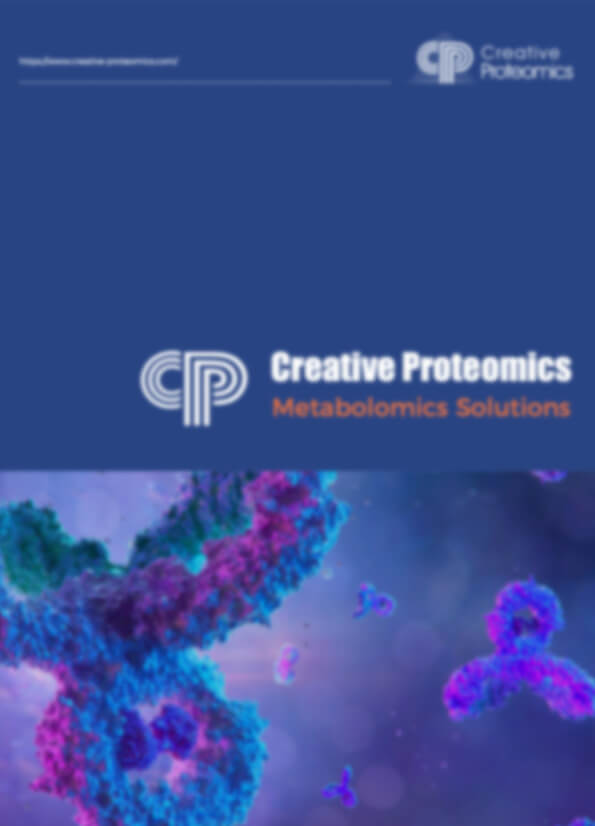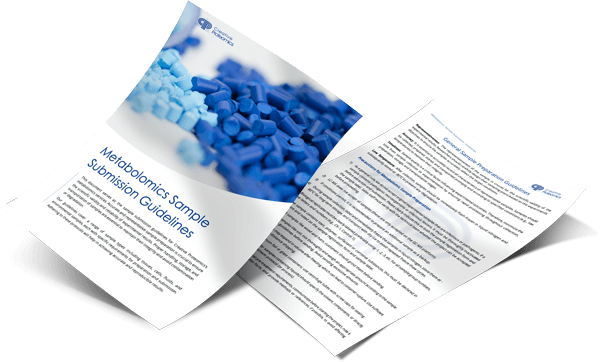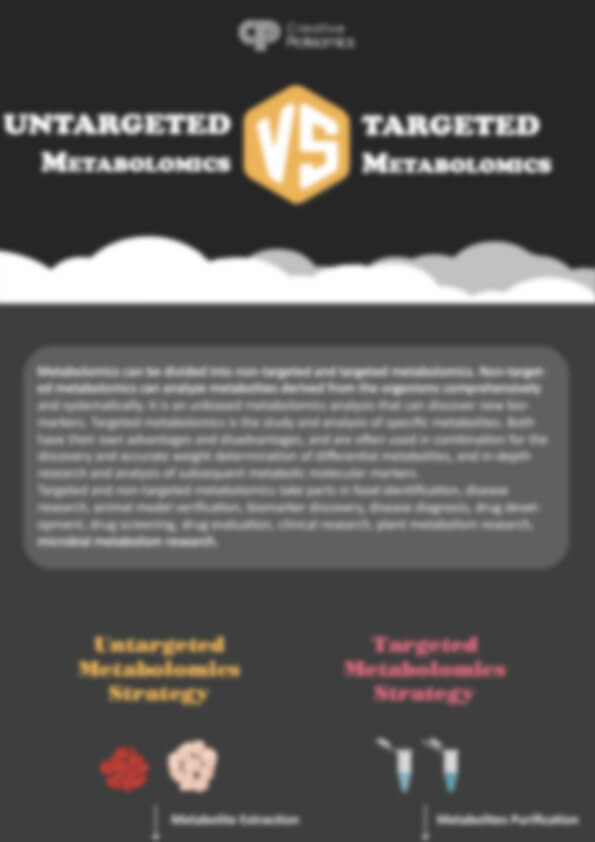Sorbitol Analysis Service
Creative Proteomics offers high-precision sorbitol analysis services using advanced LC-MS/MS and GC-MS platforms to support biomedical research, food quality control, plant physiology, and pharmaceutical development. We help clients accurately quantify sorbitol and related metabolites across diverse sample types, ensuring reliable data for metabolic studies, product formulation, regulatory compliance, and industrial QC.
Submit Your Request Now
×- What We Provide
- Advantage
- Workflow
- Technology Platform
- Sample Requirements
- FAQ
- Case Study
Overview of Sorbitol
Sorbitol, also known as glucitol, is a naturally occurring sugar alcohol that plays a critical role in the polyol pathway. In various biological systems, it is derived from the reduction of glucose via aldose reductase and subsequently oxidized to fructose by sorbitol dehydrogenase. This metabolic conversion has been implicated in a broad range of physiological and pathological processes—especially in diabetic complications, osmoregulation, and fruit ripening in plants.
In clinical research, food quality control, and pharmaceutical development, precise quantification and profiling of sorbitol and its related metabolites is essential for understanding its biological impact and industrial relevance.
Why Analyze Sorbitol?
- Biomedical Research: Sorbitol accumulation is associated with diabetic nephropathy, neuropathy, and retinopathy. Accurate analysis enables researchers to track metabolic dysregulation.
- Pharmaceutical Development: Quantifying sorbitol can support drug efficacy studies targeting the polyol pathway.
- Food & Beverage Industry: Sorbitol acts as a sweetener and humectant. Its analysis is key in formulation stability, labeling compliance, and nutritional assessments.
- Plant Physiology Studies: Sorbitol functions as a primary photosynthate in some plants. Its measurement aids in understanding stress responses and transport mechanisms.
Sorbitol Analysis Service Offered by Creative Proteomics
- Sorbitol Quantification in Research Samples: Accurate and sensitive measurement of sorbitol in biological, plant, food, and industrial matrices.
- Sorbitol Content Detection in Food and Beverages: Quantifies sorbitol in processed foods, drinks, and raw ingredients to support labeling and formulation.
- Pharmaceutical Excipient Sorbitol Analysis: Determines sorbitol concentration in drug excipients and finished products for QC and formulation control.
- Plant Tissue Sorbitol Profiling: Measures sorbitol levels in leaves, fruits, stems, or roots for plant physiology and metabolism studies.
- Sorbitol Transport Analysis in Plants: Assesses sorbitol movement between source and sink tissues to study carbon allocation under stress or development.
- Polyol Pathway Targeted Metabolite Panel: Simultaneous analysis of sorbitol, glucose, fructose, galactitol, mannitol, and myo-inositol in one run.
- Sugar Alcohol and Carbohydrate Pathway Integration: Maps sorbitol within broader carbohydrate metabolic pathways, including glycolysis and the pentose phosphate pathway.
- Sorbitol Ratio Analysis (e.g., Sorbitol/Glucose): Provides insight into metabolic shifts and pathway balance through key metabolite ratios.
- Batch Consistency Testing for Industrial Products: Evaluates sorbitol content consistency across production batches of food or pharmaceutical products.
Detected Sorbitol and Related Analytes
| Compound Name | Compound Type | Associated Metabolic Pathway(s) |
|---|---|---|
| Sorbitol | Sugar Alcohol | Polyol Pathway |
| Glucose | Monosaccharide | Glycolysis, Polyol Pathway |
| Fructose | Monosaccharide | Polyol Pathway |
| Galactitol | Sugar Alcohol | Galactose Metabolism, Polyol Pathway |
| Mannitol | Sugar Alcohol | Mannitol Pathway, Osmoregulation |
| Xylitol | Sugar Alcohol | Pentose Phosphate Pathway |
| Myo-Inositol | Cyclitol | Inositol Phosphate Pathway, Osmoregulation |
| L-iditol | Sugar Alcohol | Minor Pathways in Polyol Metabolism |
| Tagatose | Monosaccharide (ketohexose) | Galactose Degradation |
| Erythritol | Sugar Alcohol | Glycolysis-derived Polyol Pathways |
| Sorbitan | Sorbitol Derivative | Industrial Pathway (Esterification Derivatives) |
Advantages of Sorbitol Assay
- High Sensitivity and Low Detection Limits: Achieves detection limits as low as 0.1 µM for sorbitol using LC-MS/MS with isotope dilution, enabling precise analysis even in trace-level samples.
- Wide Dynamic Range: Offers a linear quantification range spanning 4–5 orders of magnitude, ensuring accuracy from low-abundance biological samples to high-concentration industrial matrices.
- Multi-Matrix Compatibility: Validated for over 15 biological and industrial sample types, including plasma, urine, plant extracts, fruits, beverages, pharmaceuticals, and fermentation broths.
- Comprehensive Pathway Coverage: Simultaneous detection of 10+ related metabolites in the polyol, glycolytic, and pentose phosphate pathways, enabling integrated metabolic insight.
- High Reproducibility and Precision: Intra-assay CV < 5% and inter-assay CV < 8% across replicated runs, ensuring robust data for both research and production environments.
- Quantitative and Qualitative Reporting: Delivers both absolute concentration (µM or mg/kg) and relative abundance profiles, with detailed pathway annotation and graphical summaries.
- Custom Assay Flexibility: Supports custom-designed panels, method development, and matrix adaptation based on project-specific requirements.
- High Throughput Capability: Capacity to process up to 200+ samples per batch, suitable for large-scale studies, breeding programs, or industrial QC pipelines.
Workflow for Sorbitol Analysis Service
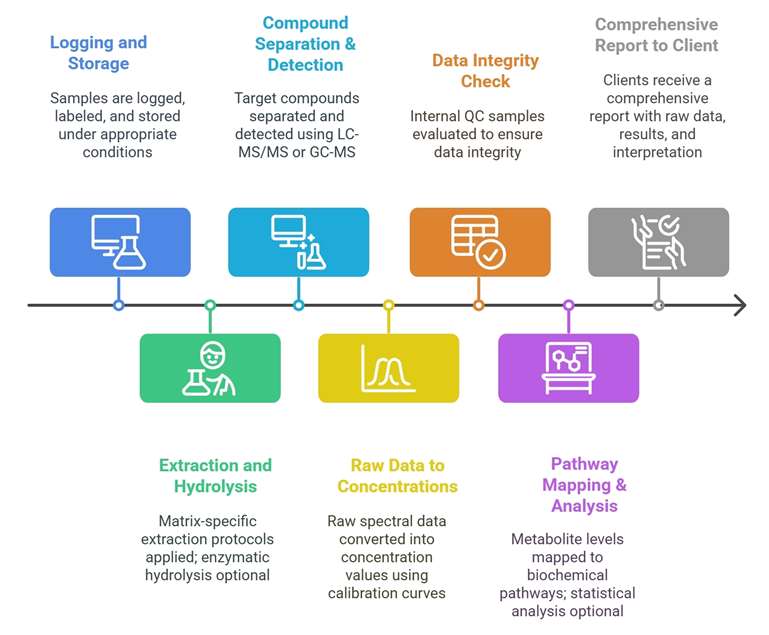
Technology Platform for Sorbitol Analysis Service
LC-MS/MS (Agilent 6495C Triple Quadrupole): High-sensitivity targeted quantification of sorbitol and related metabolites using isotope-labeled standards.
GC-MS (Agilent 7890B GC + 5977A MSD): Precise analysis of derivatized sugar alcohols in food, plant, and pharmaceutical samples.
HPLC-RID/ELSD (Agilent 1260 Infinity II): Reliable separation and quantification of sorbitol and other polyols in routine QC applications.
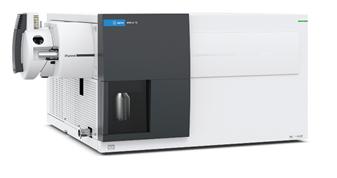
Agilent 6495C Triple Quadrupole (Figure from Agilent)
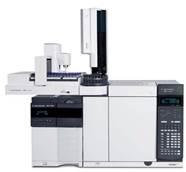
Agilent 7890B-5977A (Figure from Agilent)
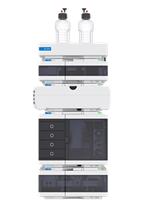
Agilent 1260 Infinity II HPLC (Fig from Agilent)
Sample Requirements for Sorbitol Analysis Service
| Sample Type | Minimum Amount Required | Notes |
|---|---|---|
| Serum / Plasma | ≥ 200 µL | Collected with anticoagulant (EDTA or heparin recommended) |
| Urine | ≥ 500 µL | Preferably first-morning sample; no preservatives |
| Tissue (Animal / Plant) | ≥ 100 mg (wet weight) | Snap-frozen and stored at –80°C |
| Cell Pellet | ≥ 1 × 10⁷ cells | Washed with PBS; frozen promptly |
| Fruit / Vegetable | ≥ 1 g (fresh or freeze-dried) | Remove seeds or pits if present |
| Fermentation Broth | ≥ 1 mL | Filtered or centrifuged before shipping |
| Food / Beverage | ≥ 5 g (solid) / ≥ 2 mL (liquid) | Homogenize if solid; avoid carbonation in beverages |
| Pharmaceutical Products | ≥ 500 mg (powder/tablet) | Include formulation details if available |
FAQ of Sorbitol Analysis Service
Can your service detect sorbitol in complex matrices like fermented beverages or syrups with high sugar content?
Yes. Our Agilent 6495C LC-MS/MS platform uses hydrophilic interaction liquid chromatography (HILIC) paired with isotope-labeled internal standards (e.g., d7-sorbitol) to resolve sorbitol from co-eluting sugars (e.g., glucose, fructose) in high-background samples. Recovery rates exceed 95% for syrups and fermented products.
How do you handle samples with low sorbitol concentrations, such as early-stage plant tissues or diluted biological fluids?
For trace-level sorbitol (e.g., <0.1 µM), we employ pre-concentration techniques:
- Solid-phase extraction (SPE): Using mixed-mode cartridges to isolate sugar alcohols.
- Derivatization (GC-MS): Silylation reagents enhance volatility and sensitivity to 0.05 ppm.
Can I request a combined analysis of sorbitol and downstream oxidative stress markers (e.g., MDA)?
Absolutely. Our polyol pathway-integrated panel includes sorbitol, fructose, and oxidative markers like malondialdehyde (MDA) and glutathione (GSH). The Thermo Fisher Q Exactive HF-X enables simultaneous quantification in a single run, reducing costs and sample volume.
What if my samples contain interfering substances, such as polysorbate surfactants or PEGs?
We apply matrix-specific cleanup protocols:
- Molecularly imprinted polymers (MIPs): Selective binding of sorbitol while excluding PEGs.
- Ultrafiltration: Remove high-MW compounds (>3 kDa) prior to LC-MS/MS analysis.
Do you provide support for interpreting sorbitol-to-glucose ratios in diabetic research models?
Yes. Reports include dynamic ratio analysis with statistical benchmarks (e.g., healthy vs. diabetic rodent models). Our bioinformatics team can overlay your data with pathway maps (e.g., KEGG polyol pathway) to contextualize metabolic imbalances.
How does your GC-MS method differentiate sorbitol from structurally similar sugar alcohols like mannitol or xylitol?
Using Agilent 7890B GC-MS, we derivatize samples with N-methyl-N-(trimethylsilyl) trifluoroacetamide (MSTFA), generating unique trimethylsilyl (TMS) ethers. Each sugar alcohol exhibits distinct retention times and fragmentation patterns (e.g., sorbitol: m/z 205, 319; mannitol: m/z 319, 361).
Can you analyze sorbitol in live cell cultures or real-time fermentation processes?
For real-time monitoring, we offer customized sampling kits with stabilizing buffers to halt enzymatic activity immediately. Our Agilent 1260 Infinity II HPLC-ELSD achieves 10-minute turnaround per sample, ideal for fermentation broth QC.
What is the minimum sample volume required for plant tissue sorbitol profiling?
As little as 20 mg of fresh weight (e.g., Arabidopsis leaves) is sufficient. For woody tissues (e.g., apple stems), we optimize extraction with microwave-assisted hydrolysis to improve yield.
Can I integrate sorbitol data with my existing omics datasets (e.g., transcriptomics)?
Yes. We provide raw data formats (mzML, .RAW) compatible with tools like XCMS Online or MetaboAnalyst, enabling cross-omics correlation studies.
How do you ensure accuracy in high-throughput industrial batch testing (200+ samples)?
We implement batch randomization and include QC spikes (low/medium/high sorbitol concentrations) every 10 samples. Data is normalized using internal standard curves to minimize instrumental drift.
Can you analyze sorbitol derivatives like sorbitan or polysorbate in cosmetics?
Yes. Using UHPLC-QTOF-MS (Agilent 6546), we characterize sorbitan esters (e.g., polysorbate 80) with mass accuracy <2 ppm and quantify residual sorbitol in emulsifiers.
Learn about other Q&A.
Sorbitol Analysis Service Case Study
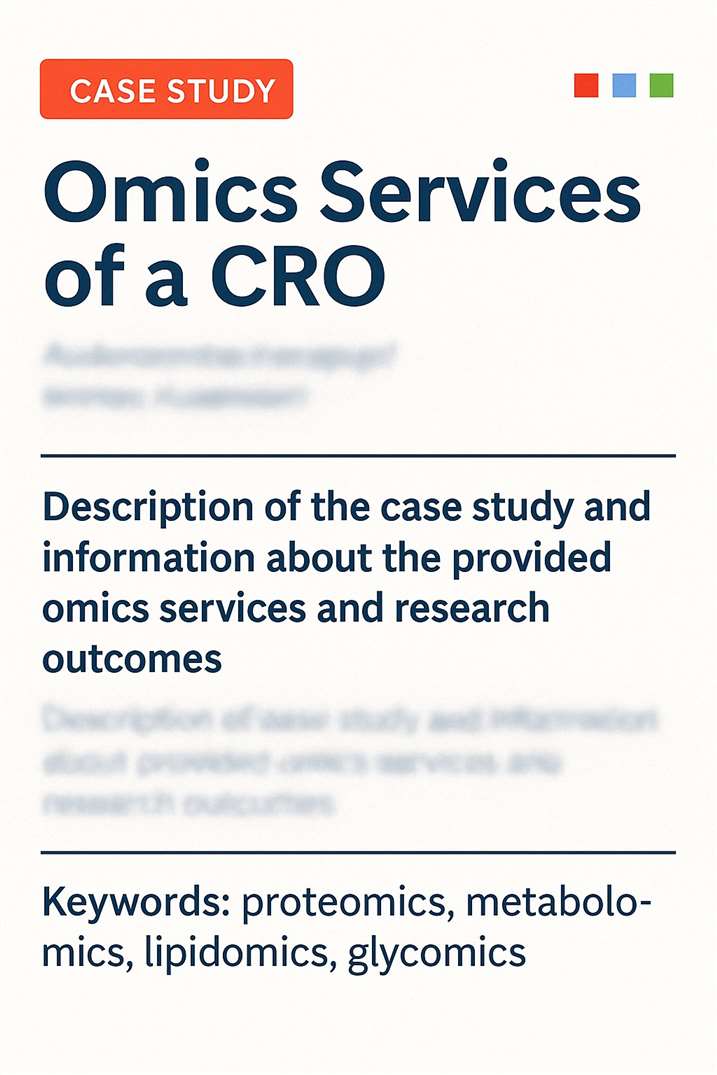
Title: Metabolome of Cerebral Thrombi Reveals an Association between High Glycemia at Stroke Onset and Good Clinical Outcome
Journal: Metabolites
Published: 2020
- Background
- Methods
- Results
- Reference
Glucose is the brain's primary fuel, yet hyperglycemia upon hospital admission typically correlates with poor stroke outcomes. This paradox may stem from a lack of data on blood glucose levels at stroke onset, as admission glycemia is influenced by stress responses and may not reflect initial conditions. By analyzing the metabolome of blood cells trapped in cerebral thrombi retrieved via mechanical thrombectomy, the study investigates glucose metabolism at stroke onset. Using metabolomics techniques, sorbitol—a short-term glycemic index—and glucose levels in thrombi were linked to favorable clinical outcomes, suggesting high glycemia at stroke onset may be beneficial, challenging prior assumptions.
- This study analyzed cerebral thrombi from acute ischemic stroke patients undergoing mechanical thrombectomy using the ThrombiOMIC database. Inclusion criteria were NIHSS ≥ 6, ASPECT ≥ 6, and complete recanalization (mTICI 2a or 3) within 6 hours of onset. Clinical and imaging data were collected per standard protocols.
- Thrombi were washed, stored at −80 °C, and processed for proteomic and metabolomic analyses. Proteins were extracted, quantified, and prepared by trypsin digestion (proteomics) or methanol precipitation (metabolomics). Metabolomics used HPLC-Orbitrap MS with data processed via MZmine2 and Metlin database. Proteomics employed nano-LC coupled to Orbitrap MS with peptide identification through Proteome Discoverer against Uniprot.
- Statistical analysis included univariate tests, Spearman correlation, and multivariate sPLS-DA using MetaboAnalyst 4.0. ROC analysis identified metabolites linked to outcomes.
Creative Proteomics offers end-to-end solutions for such studies, including sample preparation, high-resolution metabolomic and proteomic profiling, advanced data analysis, biomarker discovery, and comprehensive reporting tailored for clinical research.
41 stroke patients successfully treated by mechanical thrombectomy were analyzed; 44% had favorable outcomes (mRS 0-1) at 3 months. Age, baseline NIHSS, and admission glycemia were significantly associated with outcomes.
Proteomic analysis showed no significant differences in thrombi composition between outcome groups.
Untargeted metabolomics identified 5019 features; sorbitol levels in thrombi were significantly higher in patients with favorable outcomes (p < 0.0001). Sorbitol was confirmed by LC-MS/MS.
Sorbitol accumulation correlated with elevated glucose in thrombi, linked to the polyol pathway activity, without changes in glycolysis enzymes.
Sorbitol levels in thrombi predicted favorable outcomes independently and more accurately (AUC = 0.908) than admission glycemia (AUC = 0.644).
Sorbitol levels correlated with glycemia at stroke onset but were independent of long-term glycemic control (HbA1c), highlighting sorbitol as a marker of acute glycemia relevant to prognosis.
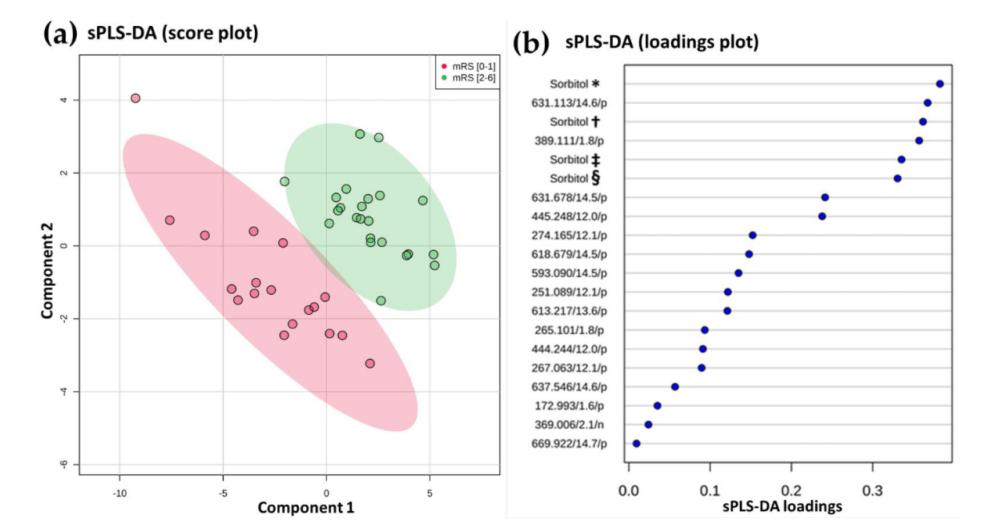 Metabolomic analysis of cerebral thrombi distinguishes stroke patients by 3-month clinical outcomes using sPLS-DA. (a) Score plot with 95% confidence ellipse (red: mRS 0–1; green: mRS 2–6). (b) Loading plot of top 20 features on component 1, with metabolite names or mz/retention time/ion mode. Sorbitol appears in multiple adduct forms.
Metabolomic analysis of cerebral thrombi distinguishes stroke patients by 3-month clinical outcomes using sPLS-DA. (a) Score plot with 95% confidence ellipse (red: mRS 0–1; green: mRS 2–6). (b) Loading plot of top 20 features on component 1, with metabolite names or mz/retention time/ion mode. Sorbitol appears in multiple adduct forms.
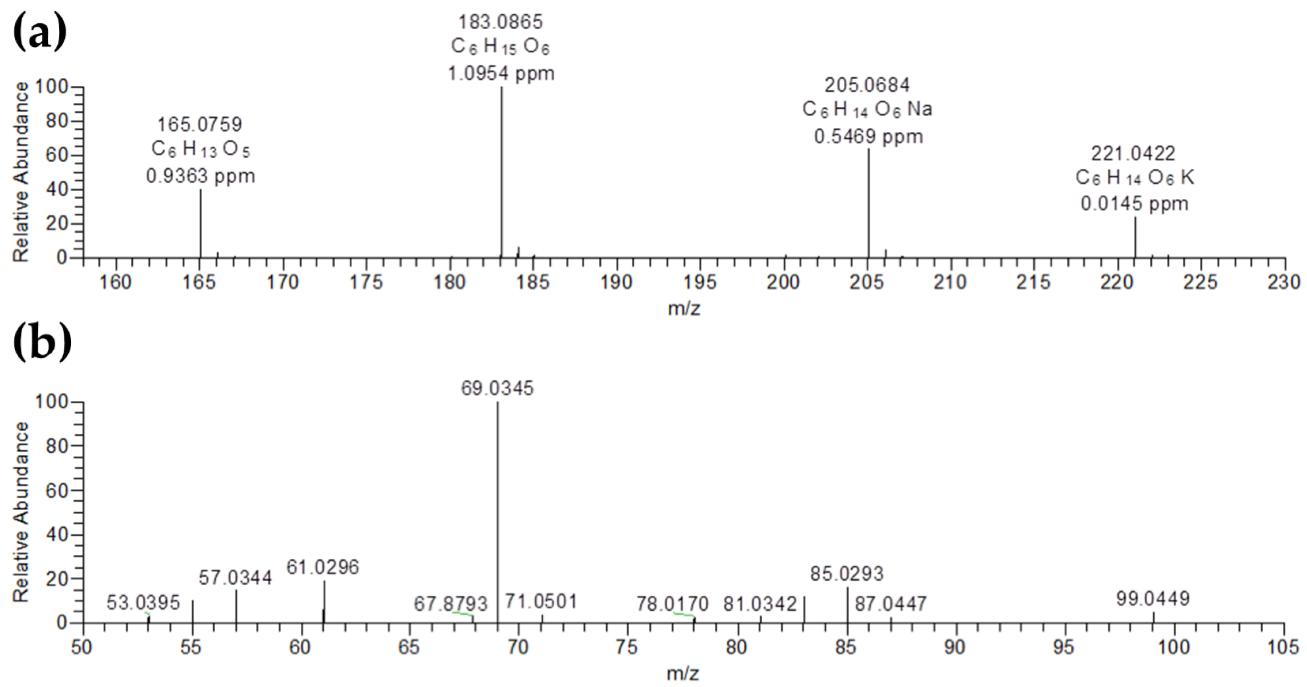 LC-MS/MS identification of sorbitol
LC-MS/MS identification of sorbitol
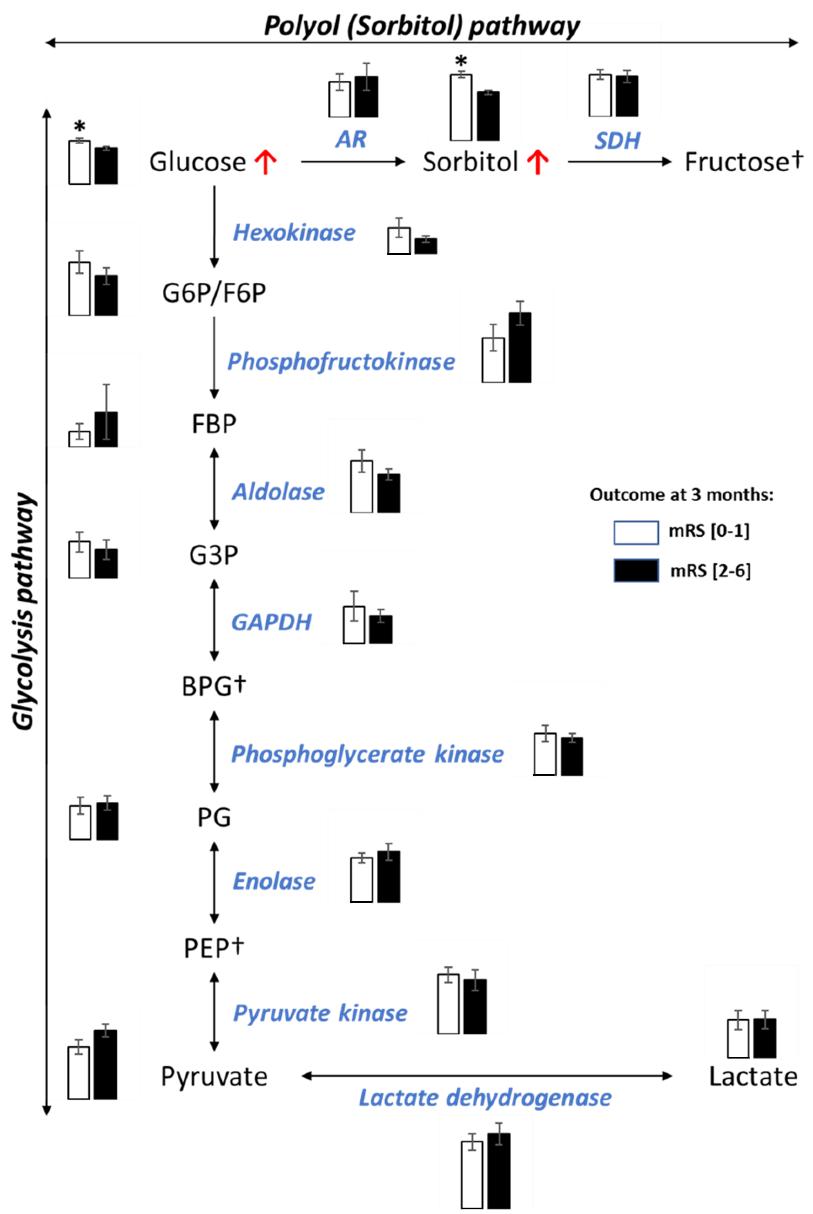 Metabolomic and proteomic analyses of the polyol (sorbitol) and glycolytic pathways of cerebral thrombi.
Metabolomic and proteomic analyses of the polyol (sorbitol) and glycolytic pathways of cerebral thrombi.
Reference
- Suissa, Laurent, et al. "Metabolome of cerebral thrombi reveals an association between high glycemia at stroke onset and good clinical outcome." Metabolites 10.12 (2020): 483. https://doi.org/10.3390/metabo10120483
Publications
Here are some publications in Metabolomics research from our clients:

- Lipid droplet-associated lncRNA LIPTER preserves cardiac lipid metabolism. 2023. https://doi.org/10.1038/s41556-023-01162-4
- Methyl donor supplementation reduces phospho‐Tau, Fyn and demethylated protein phosphatase 2A levels and mitigates learning and motor deficits in a mouse model of tauopathy. 2023. https://doi.org/10.1111/nan.12931
- Lipin-1 regulates lipid catabolism in pro-resolving macrophages. 2020. https://doi.org/10.1101/2020.06.03.121293
- Enhance trial: effects of NAD3® on hallmarks of aging and clinical endpoints of health in middle aged adults: a subset analysis focused on blood cell NAD+ concentrations and lipid metabolism. 2022. https://doi.org/10.3390/physiologia2010002
- Insect derived extra oral GH32 plays a role in susceptibility of wheat to Hessian fly. 2021. https://doi.org/10.1038/s41598-021-81481-4
